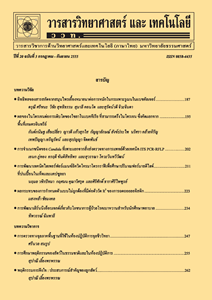Effects of pH and Waste Water Loading on Fat Oil and Grease Adsorption Efficiency by Cattail Flowers Sugarcane Bagasse and Water Hyacinth
Main Article Content
Abstract
In this work, the investigation of the potential of acidity and basicity (pH) and amount of synthetic wastewater affecting the efficiency of the fat oil and grease adsorption and the filtration of the suspended solid was carried out using cattail flowers, sugarcane bagasse and water hyacinth as adsorbents. The synthetic wastewater used in the study was similar to community wastewater. The pH of the synthetic wastewater used in the study was adjusted to 4, 5, 6, 7, and 8. Twenty grams of adsorbent was used to adsorb oil and grease in two liters of the wastewater. The results indicated that the pH of the wastewater was 7 with the cattail flowers as an adsorbent that were suitable for adsorbing fat oil and grease. The efficiency of fat oil and grease adsorption and the percentage of removal suspended solid were 99.54 and 80.61 %, respectively. The results showed that when synthetic wastewater increased to 3, 4, 5, 6 and 7 liters, the ability of the fat oil and grease adsorption in the synthetic wastewater decreased. The cattail flowers (20 grams) could adsorb the oil and grease of 4 liters. The synthetic wastewater, the fat oil and grease remaining in the synthetic wastewater did not exceed the standard of the community effluent. In addition, the results pointed out that the filtration of the suspended solid decreased if the synthesis wastewater increased.
Article Details
References
Pollution Control Department, Manual of Wastewater Sludge Management, Available Source: http://www.pcd.go.th/public/Publications/print_ water.cfm?task=wt, September 22, 2016. (in Thai)
Wisetrat, O., Ngamsombat, R., Saueprasear sit, P. and Prasara, A.J., 2012, Adsorption of suspended oil using bagasse and modified bagasse, J. Sci. Tech. Mahasarakham Univ. 31(4): 354-362. (in Thai)
Ahmad, A.L., Bhatia, S., Ibrahim, N. and Sumathi, S., 2005, Adsorption of residual oil from palm oil mill effluent using rubber powder, Braz. J. Chem. Eng. 22: 371-379.
Pollution Control Department, 2008, Manual of Oil and Grease from Grease Trap Management and Its Benefit, TQP Press, Bangkok, 37 p. (in Thai)
Jiramaitree, M., 2008, The Development of Grease Tank Using Coconut Husk as a Filter, Master Thesis, Srinakharinwirot University, Nakhon Nayok. (in Thai)
Rani, M.J., Murugan, M., Subramaniam, P., and Subramanian, E., 2014, A study on water hyacinth Eichhornia crassipes as oil sorbent, J. Appl. Nat. Sci. 6: 134-138.
Lamdual, R., Wibuloutai, J. and Phonpi molthape, C., 2010, Efficiency of oil removal from cafeteria wastewater by using flower of Typha angustifoli Linn., J. Environ. Manag. 6(1): 42-51. (in Thai)
Wahi, R., Chuah, L.A., Choong, T.S.Y., Ngaini, Z. and Nourouzi, M., 2013, Oil removal from aqueous state by natural fibrous sorbent: An overview, Sep. Purif. Technol. 113: 51-63.
Ibrahim, S., Ang, H. and Wang S, 2009, Removal of emulsified food and mineral oils from wastewater using surfactant modified barley straw, Bioresour. Technol. 100: 5744-5749.
Simonovic, B.R., Arandelovic, D., Jovanovic, M., Kovacevic, B., Pezo, L. and Jovacevic, A., 2009, Removal of mineral oil and wastewater pollutants using hard coal, Chem. Ind. Chem. Eng. Q. 15: 57-62.
Tanthunwet, M. and Tanthunwet M., 2008, Water Quality Analysis Guide, Chulalongkorn University Press, Bangkok, 446 p. (in Thai)
Ghali, L., Msahli, S., Zidi, M. and Sakli, F., 2008. Effect of pretreatment of Luffa fibers on the structural properties, Mater. Lett. 63: 61-63.
College of Nanotechnology, King Mongkut’s Institute of Technology Ladkrabang, 2013, Oil Removal from Flower of Cattail flowers, Available Source: http://www.nano.kmitl.ac.th/index.php/reser/360, September 22, 2016. (in Thai)
Suriyapunpong, D., 2014, Isolation and Characterization of Cellulose from Water Hyacinth Sugarcane Bagasse and Narrow Leaf Cattail, Technical Report, Faculty of Pharmacy, Srinahkarinwirot University, Nakhonnayok. (in Thai)
Kastrachoy, P., 2014, Efficiency Filtration Grease Trap Decrease Oil Grease from Municipal Wastewater, Master Thesis, Nakhonratchasima Rajabhat University, Nakhon Ratchasima. (in Thai)
Lim, T. and Huang, X., 2006, In situ oil/water separation using hydrophobic – oleophilic fibrous wall: A lab-scale feasibility study for groundwater cleanup, J. Hazard. Mater. 137: 820-826.
Teankaprasith, K. and Pongsantisuk, S., 2002, Oil spill cleanup by using natural materials as sorbents, Thai Sci. Technol. J. 10(2): 26-31. (in Thai)


